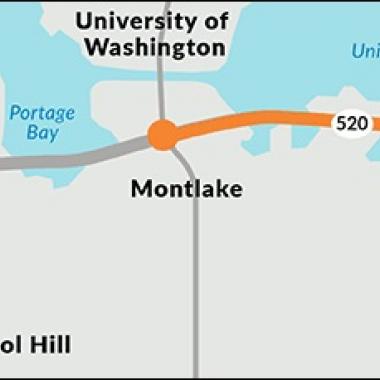Project overview
The Montlake Project will improve transportation for both motorized and nonmotorized travel along the corridor with a new SR 520 eastbound bridge over Union Bay. This project also builds a new, three-acre lid covering the highway in Montlake that will include regional transit stops and open green space. East of the lid, a bicycle and pedestrian bridge will be constructed over SR 520.
What to expect
All current closure information and additional details can be found on the SR 520 Construction Corner webpage.
Area map of SR 520 Montlake Project in Seattle
Plans and process
The old SR 520 west approach bridge, built in the early 1960s, served as a vital link across Union Bay. It connected the highway between Montlake and the floating bridge. Built on hollow columns, the old bridge was vulnerable to earthquakes, and the highway’s location divided the Montlake community. The new eastbound bridge, parallel to the westbound bridge that opened in 2017, will provide safer and more reliable travel. This project will also reconnect the Montlake community with a landscaped lid over the highway.
The Montlake Project is a key piece of the SR 520 Bridge Replacement and HOV Program. It’s the first phase of the “Rest of the West” – the final improvements to the SR 520 corridor in Seattle. The SR 520 Program’s Final Environmental Impact Statement included these projects in its analysis. WSDOT refined the project’s final design through a community engagement process with local government partners, design professionals and community members. This resulted in significant design changes, including redesigning the lid to emphasize better travel connections and more usable open space. It also led to the inclusion of a bicycle and pedestrian bridge east of the lid. You can read more on the SR 520 Program Community Engagement tab.
Project design
The SR 520 Program’s community engagement tab contains extensive information about the design development process for the Montlake Project. Visit the Montlake Project Maps & Drawings tab for images of key project elements.
Project benefits
SR 520’s 1960s-era west approach bridge, supported by hollow columns, was at risk of failure in a severe earthquake. In addition, the highway’s old four-lane segment in Seattle is typically at capacity during peak periods. This project provides a number of benefits:
- A safer and seismically stronger eastbound bridge, parallel to the completed westbound bridge, connecting Seattle’s Montlake neighborhood to the new floating bridge.
- New community open space and trail connections from construction of a landscaped freeway lid in Montlake.
- Improved regional mobility through the addition of transit and carpool lanes across Lake Washington. Also through direct-access transit and carpool ramps on the Montlake lid and added lane capacity at the Montlake Boulevard interchange.
- More nonmotorized travel options from a new north-south bicycle and pedestrian bridge over SR 520, connecting Arboretum trails with routes in Montlake and the University District.
- Fewer traffic backups thanks to wider highway shoulders that allow disabled vehicles to pull over without blocking traffic.
- A cleaner, healthier environment through new systems to treat stormwater runoff from the highway.
- Removal of old SR 520 on- and off-ramps and the never-completed R.H. Thomson Expressway "Ramps to Nowhere" to create a more natural experience in the arboretum.
This project is a central part of the larger, ongoing megaprogram that is reconstructing the SR 520 corridor from I-405 in Bellevue to I-5 in Seattle. We’ve completed several phases of the larger SR 520 Bridge Replacement and HOV Program, including:
- Floating Bridge and Landings Project, which built the world’s longest floating bridge across Lake Washington between Seattle and the Eastside. This project also built 44 of the bridge’s smaller pontoons in Tacoma.
- Pontoon Construction Project, which built 33 of the new floating- bridge’s pontoons, including its massive “longitudinal” pontoons, in Tacoma and in Aberdeen, Washington.
- Eastside Transit and HOV Project, which rebuilt the highway’s Eastside segment between I-405 and Lake Washington’s east shore.
- West Approach Bridge North Project, which completed the first of two parallel west approach bridges over Union Bay, between the floating bridge and Seattle’s Montlake neighborhood.
When the corridor’s reconstruction is fully completed in the late 2020s:
- All of SR 520’s major bridges will be replaced with stronger structures.
- The bus/carpool lanes and a regional bicycle/pedestrian path will extend from Seattle east to Redmond.
- Travelers will have safer on- and /off- ramps and improved connections to transit, local streets and the local and regional trail networks.
A commitment to equitable contracting
WSDOT is committed to providing equitable contracting opportunities to minority-owned, women-owned, veteran-owned and disadvantaged small businesses (MSVWBEs). Our goal is to provide 26 percent of our transportation projects’ contract value to these firms. See our equal opportunity in contracting webpage for more information and resources for working with WSDOT.
The SR 520 Montlake Project expects to have additional business opportunities for qualified firms owned by minorities, women or veterans. Subcontractors interested in working with Graham, the prime contractor for the Montlake Project, should contact:
- Tom McMillan, Graham’s Montlake Project procurement manager, at Tom.McMillan@grahamus.com.
- Suzanne Arkle, Graham’s Diversity Manager, at (720)-324-8580 or Suzanne@zanninc.com
- Regina Glenn, WSDOT’s Megaprograms Diversity and Inclusion Manager, at GlennRe@consultant.wsdot.wa.gov
- Dave Becher, WSDOT’s SR 520 Program Director of Construction, at Dave.Becher@wsdot.wa.gov
WSDOT, Graham and subcontractors American Bridge and Elcon held an online meeting on Sept. 28, 2020. This meeting was with minority-, woman- and veteran-owned businesses to discuss upcoming contracting opportunities on the SR 520 Montlake Project. If you missed the meeting, you can view the presentation (PDF 1MB) to see the information we shared. You also can read this Q&A (PDF 196KB) posed by meeting participants.
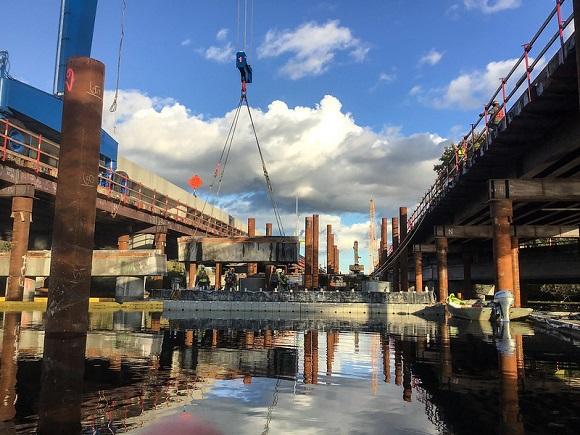
Crews from American Bridge, a subcontractor to Graham, remove pieces of the old eastbound bridge on Lake Washington.
Montlake Project Community Workforce Agreement
WSDOT implemented a Community Workforce Agreement (CWA) for this project. The CWA provides a variety of benefits to WSDOT, its contractors and the skilled construction workers building the project. The agreement also aligns WSDOT with other public agencies in the region that use similar labor agreements on their projects. Learn more by reading our SR 520 CWA folio (PDF 2MB) or view the SR 520 CWA document (PDF 5MB) for additional details.
Small and minority businesses working as subcontractors on the Montlake Project have a resource to help them navigate the CWA’s provisions. This resource is a company called Intelligent Partnerships. WSDOT hired Intelligent Partnerships as the CWA Administrator for the Montlake Project. Intelligent Partnerships works alongside the contractor to implement the agreement.
You can reach Intelligent Partnerships at (877) 234-9737.
Promoting apprenticeships on the Montlake Project
WSDOT contracts worth $3 million or more contain a 15% apprenticeship utilization requirement. The requirement obligates contractors to use a hiring program approved by the Washington State Apprenticeship and Training Council. In addition, contractors and their subcontractors must meet the 15% apprenticeship requirement.
WSDOT's SR 520 Montlake Project includes a 20% apprenticeship utilization requirement for each craft. Of that amount, aspirational goals are set at 21% for minority apprentices and 12% for women apprentices.
The Montlake Project contractor, Graham, was given notice to proceed with construction in November 2018, with project completion estimated for approximately 2023. As of February 2021, Graham achieved 15% apprenticeship utilization. Through a WSDOT-sanctioned, preferred-entry program that provides apprenticeship or pre-apprenticeship training, Graham works with unions and other community partners to engage apprentices.
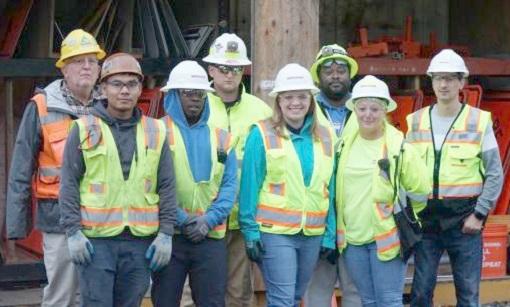
From left to right: John Donovan (laborer journeyman). Luis Marchan Hernandez (laborer apprentice). Ja'Mahri Mitchell (laborer apprentice). Aaron Childers (operator apprentice). Brittany Grenard (Graham’s apprenticeship coordinator). Foluke Jackson (laborer apprentice). Mary Wing (laborer apprentice). Marek Bednarczyk (senior project manager).
You can reach Brittany Grenard, Graham’s HR apprenticeship coordinator, at Brittany.Grenard@graham.ca or 425-620-6038.
This project is part of the $2 billion in SR 520 improvements from Lake Washington to I-5 – the “Rest of the West.” These improvements are funded by the 2015 Connecting Washington and 2022 Move Ahead Washington transportation legislation packages.
Plan view of key Montlake project elements. View a larger image (PDF 476KB)
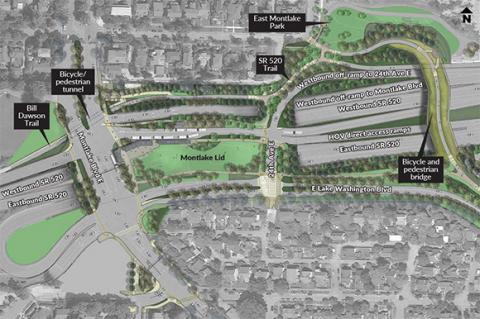
The future Montlake lid over SR 520, looking west, with 24th Avenue East in the foreground and Montlake Boulevard in the distance.
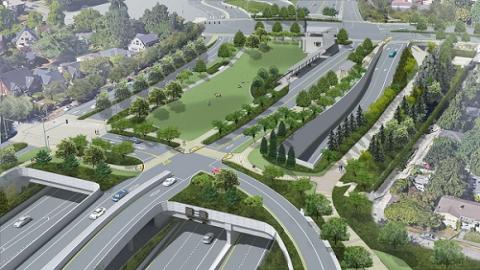
Monthly Montlake Project construction update meeting
You can view the December presentation online (PDF 6.2MB) or view the meeting recording on YouTube.
Montlake Project signage community update
We’ve heard concerns from Montlake neighbors about the sign bridges installed at the reconstructed SR 520/Montlake Boulevard interchange. See below for the latest update.
2024 Legislative Session outcome
As we’ve mentioned before, our ability to implement the workgroup’s recommendations depended on additional funding provided by the Legislature. The final supplemental transportation budget directed us to move forward with awarding the Portage Bay Bridge and Roanoke Lid Project and “seek consequential cost reduction opportunities through value engineering and prioritizing functionality and usability of the Portage Bay Bridge and Roanoke Lid.” The budget did not include funding to install the alternative sign structures on Montlake Boulevard. Following the legislative session, legislators continued discussions on this issue and identified a path forward to implement the Montlake signage workgroup’s recommendations.
Next steps
In September 2024, workgroup members decided to forgo reconvening to discuss an alternative paint color. They recommended maintaining the black color of the sign structure. WSDOT will contract the Montlake signage work to Skanska, design-builder for the Portage Bay Bridge and Roanoke Lid Project. Once contracted, Skanska will need to finalize the design and procure materials. This process will take at least a year, with an estimated completion date of no sooner than summer 2025.
Montlake Project signage meeting materials:
- Montlake Project signage: Community engagement report (PDF 2.4MB)
- Jan. 31 Community meeting summary (PDF 290KB)
- Jan. 31 Community meeting YouTube recording
- Jan. 31 Community meeting PowerPoint presentation slides (PDF 1.3MB)
- Jan. 24 Workgroup meeting #4 summary (PDF 2.8MB)
- Jan. 10 Workgroup meeting #3 summary (PDF 3.5MB)
- Dec. 13 Workgroup meeting #2 summary (PDF 7.8MB)
- Nov. 29 Workgroup meeting #1 summary (PDF 2.9KB)
- Oct. 26 Community meeting summary (PDF 666KB)
- Oct. 26 Community meeting PowerPoint presentation slides (PDF 4MB)
- Oct. 26 Community meeting YouTube recording
Here are some resources you can use to stay informed about this project:
- Check the SR 520 Construction Corner Map for the latest closure information.
- For more information about how we manage construction effects, including our nighttime noise variance from the city of Seattle and weekly noise reports, visit the SR 520 Construction Corner Managing Construction Effects page.
- Twitter: @wsdot_520
- Montlake Project Flickr collection
- Montlake Project YouTube playlist
- Montlake Project construction cameras, updated every 10 minutes
- SR 520 Program home page
Project Team
sr520bridge@wsdot.wa.gov
206-775-8885 (call or text, 24-hr. construction hotline)
If your organization is interested in receiving a project briefing or presentation, please contact us.

